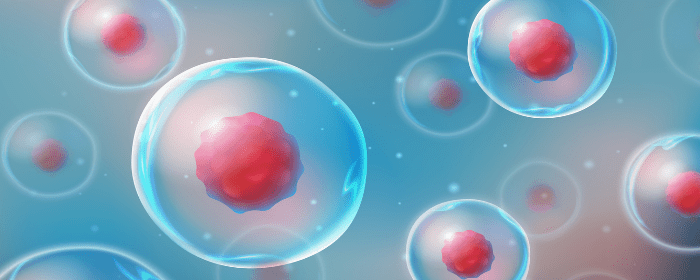
by admin | Jul 8, 2022 | Mesenchymal Stem Cells, Stem Cell Research
Human Mesenchymal Stem Cells (hMSCs) are the non-hematopoietic, multipotent stem cells with the capacity to differentiate into mesodermal lineages such as osteocytes, adipocytes, and chondrocytes as well ectodermal (neurocytes) and endodermal lineages (hepatocytes).
Until recently, when the immunomodulation properties of MSCs were proven to be clinically relevant, the use of these stem cells was met with skepticism and doubt by a large portion of the scientific community.
However, since that time, MSCs have demonstrated tremendous potential for allogeneic use in a number of applications, including cell replacement, and tissue regeneration, and for use in the therapeutic treatment of immune- and inflammation-mediated diseases. In fact, in many cases, the use of MSCs has been so successful that they appear to demonstrate more efficacy than what has been observed previously in traditional regenerative medicine.
Among the many benefits making MSCs so interesting for this application is their capacity for both multilineage differentiation and immunomodulation. Obtaining a better understanding of these capacities has opened new doors in regenerative medicine and demonstrated that these somatic progenitor cells are highly versatile for a wide range of therapeutic applications.
Additionally, the authors of this review point to research indicating the capacity of MSCs to home to the site of injury and/or inflammation, making them more attractive for use in clinical application. In this review, Wang et al. focus on this non-traditional clinical use of tissue-specific stem cells and highlight important findings and trends in this exciting area of stem cell therapy.
At the time this review was published, there were over 500 MSCs-related studies registered with the NIH Clinical Trial Database. Interestingly, nearly half of these trials involve attempts to better understand the use of MSCs in treating immune- and inflammation-mediated diseases – an indication of the recent shift in focus when determining effective therapeutic applications of MSCs.
In reviewing these clinical trials, Wang et al. found that the most common immune-/inflammation-mediated indications in MSC clinical trials were for graft-versus-host disease (GVHD), osteoarthritis (OA), obstructive airway disease, multiple sclerosis (MS), and solid organ transplant rejection.
Clinical trials involving MSCs, and specifically HSCs, in GVHD have indicated that while there may be indications of immunosuppressant therapy, immune rejection in the form of GVHD is still a major cause of morbidity and mortality, occurring in 30 ~ 40 % of allogeneic HSC transplantations.
Despite a number of clinical trials indicating significant efficacy in the use of MSCs for GVHD treatment, the authors point out that these findings were not observed consistently throughout all trials. Significant differences in these studies appeared to be related to differences in adult and pediatric applications, a specific type of HSC that was transplanted, and the type of MSCs that were utilized. There also appears to be a disparity in the results obtained from similar studies conducted in Europe and North America. Considering this, there are a number of studies involving MSCs and GVHD still ongoing.
These findings led the authors to conclude that despite the strong potential of MSCs as therapeutic agents for GVHD, detailed tailoring of the patient population and stringent MSC processing criteria are necessary to deliver consistent and reproducible results.
Despite the mixed findings for use of MSCs in the treatment of GVHD, trials reviewed for other immune/inflammation-mediated diseases, including MS, inflammatory bowel disease, OA, RA, and inflammatory airway and pulmonary diseases demonstrated positive results pertaining to the safety of MSC therapy when used in this application.
Specifically, Wang et al. point out that although there have been positive results observed in preclinical animal studies, these results have not translated to clinical efficacy. In considering this, the authors suggest a focus on better clarifying pathophysiological details and subsets within disease entities to better tailor MSC therapy and standardization of in vitro culture protocols with stringent criteria for testing of functional parameters as two important steps to improve our understanding on the mechanistic properties of MSC immunomodulation.
Despite these recommendations, the authors conclude that the current results and developments of these clinical trials demonstrate that the tremendous potential of MSC therapy in a wide range of areas, including the treatment of immune/inflammation-mediated diseases, can be expected in the near future to achieve clinical relevance.
Source: “Human mesenchymal stem cells (MSCs) for treatment towards ….” 4 Nov. 2016, https://www.ncbi.nlm.nih.gov/pmc/articles/PMC5095977/.

by admin | May 13, 2022 | Mesenchymal Stem Cells, Stem Cell Research
Multiple system atrophy (MSA) is a rare, degenerative adult-onset neurological disorder that affects your body’s involuntary functions, including blood pressure, breathing, bladder function, and motor control. MSA also demonstrates several symptoms similar to those accompanying Parkinson’s disease, including slow movement, stiff muscles, and loss of balance[1].
Considering the rapid and fatal progression of MSA, there are not currently any long-term drug treatments known to produce therapeutic benefits against the condition. The typical neuropathological hallmarks of MSA are bone marrow destruction and cell loss in the striatonigral region of the brain that results in dopamine deficiency significant enough to result in behavioral abnormalities.
Since mesenchymal stem cells (MSCs) have demonstrated the ability to self-renew and differentiate within a wide variety of tissues, Park et al., in this study, aimed to assess whether the transplantation of human-derived MSCs could have beneficial effects in a double-toxin-induced MSA rat model. Additionally, the authors assessed the signaling-based mechanisms underlying the neuroprotective effects of MSCs.
Specifically, as part of this study, Park et al. studied the effects of MSCs in 60 rats randomly allocated to one of six groups – a control group, a double-toxin group, two groups receiving MSC intra-arterial (IA) injections, and two groups receiving MSC transplantation via intrathecal (IT) injection after double-toxin induction.
After receiving treatment each group of rats underwent a variety of tests, including the Rotarod test, gait test, and grip strength test. Additionally, the brain tissue of the rats was collected, preserved, and evaluated to assess notable differences.
At the conclusion of this study, the authors found clear evidence of the protective effects of MSCs on double-toxin-induced MSA. The study also demonstrated that transplantation of MSCs prevented neuronal cell death and improved behavioral disorders caused by double-toxin-induced MSA, specifically by reducing dopaminergic neurodegeneration and neuroinflammation.
Additionally, Park et al.’s study demonstrated a higher expression of polyamine modulating factor-binding protein 1 and a lower expression of 3-hydroxymethyl-3-methylglutaryl-COA lyase (HMGCL) after MSC transplantation.
Park et al. also point out that further investigation is required to better understand the exact mechanism of neuron-specific knockdown in vivo animal and clinical trials.
The authors of this study conclude that treating MSA with bone-marrow-derived MSCs protects against neuronal loss by reducing polyamine- and cholesterol-induced neural damage and may represent a promising new therapeutic treatment option for MSA.
Source: “Prevention of multiple system atrophy using human bone marrow ….” 11 Jan. 2020, https://stemcellres.biomedcentral.com/track/pdf/10.1186/s13287-020-01590-1.pdf.
[1] “Multiple system atrophy (MSA) – Symptoms and causes – Mayo Clinic.” 21 May. 2020, https://www.mayoclinic.org/diseases-conditions/multiple-system-atrophy/symptoms-causes/syc-20356153. Accessed 4 Apr. 2022.

by Stemedix | Mar 21, 2022 | Stem Cell Therapy, Autoimmune, Mesenchymal Stem Cells
For decades, autoimmune diseases such as Lupus, Rheumatoid Arthritis, and chronic obstructive pulmonary disease (COPD) have posed a major challenge to researchers and healthcare providers. While medical interventions have evolved tremendously in the last few decades, these serious conditions remain notoriously difficult to treat. Here we talk about Stem Cell for Autoimmune Diseases, Specifically Mesenchymal stem cells!
Fortunately, mesenchymal stem cells may be a potentially effective treatment option for many patients suffering from various autoimmune conditions. While the efficacy of this intervention varies depending on unique patient factors, individuals who have had little to no success with traditional interventions may find it useful to consider MSC therapy.
What Are MSCs?
Mesenchymal stem cells are a special type of cell that can transform into other types of cells. MSCs can become specialized cells such as those that form muscular tissue, cartilage, and many others. MSCs can be harvested from many different locations, including bone marrow, adipose (fat) tissue, and the Wharton’s Jelly within umbilical cords.
Once harvested, MSCs can be administered to help manage various conditions and their symptoms. MSCs are typically administered through a systemic application into the blood system. However, they can also be directly administered to have a more targeted impact on a specific area depending on the patient’s case.
Can MSCs Be Used to Treat Autoimmune Diseases?
While MSCs are still being studied, research has indicated that MSCs can be an effective intervention for many different autoimmune conditions, including COPD.
Specifically, mesenchymal stem cells have been effective at treating chronic inflammation, which is a common symptom in many autoimmune patients.
However, every case and patient is unique. Therefore, treatment decisions should be made with the guidance of a licensed medical professional. An experienced care provider can thoroughly review your medical history and condition to help you select the best treatment plan for your needs.
Potential Benefits of Stem Cell for Autoimmune Diseases MSCs
Mesenchymal stem cells have the unique potential to reduce inflammation in individuals suffering from an autoimmune disease, such as Lupus or Rheumatoid Arthritis. There is a correlation between a reduction in inflammation and improvements in other disease symptoms. However, the strength of this correlation is still being researched.
With that being said, MSCs may reduce the severity of many common autoimmune symptoms, including pain and fatigue.
Although research is still in progress, mesenchymal stem cell therapy has shown promise for patients looking for an alternative option. With new advancements in medical tools and therapeutic methodologies, patients who suffer from autoimmune disorders may soon have more options for relief than ever before. If you are interested in learning more about Stem Cell for Autoimmune Diseases, contact us today and speak with a care coordinator!

by Shoot To Thrill Media | Oct 25, 2025 | Degenerative Disc Disease
Medical Review: Dr. Gerald Mastaw, MD – Board-Certified Physician
Last Updated: October 2025
What Is Degenerative Disc Disease?
Degenerative Disc Disease (DDD) occurs when the spinal discs, the soft, cushion-like pads between vertebrae, begin to lose hydration, elasticity, and height.
As discs deteriorate, they absorb less shock, which can lead to pain, stiffness, and nerve irritation if nearby nerves are compressed.
Common Symptoms
- Persistent or recurring neck or lower back pain
- Discomfort that worsens with bending, lifting, or prolonged sitting
- Stiffness after activity or upon waking
- Tingling, numbness, or weakness in arms or legs if nerves are affected
Age is the most common cause, but injury, repetitive strain, genetics, smoking, and excess body weight can accelerate disc wear.
Conventional Treatment Approaches
Most patients start with conservative therapy focused on relieving pain and improving mobility.
Common Treatments
- Physical therapy: improves flexibility, posture, and spinal support
- Anti-inflammatory medications or short-term muscle relaxants
- Heat, ice, or gentle stretching to ease discomfort
- Epidural steroid injections for nerve-related pain
For more advanced cases, procedures like radiofrequency ablation, spinal decompression, or surgery (e.g., disc replacement or spinal fusion) may be considered.
While these treatments reduce symptoms, they do not restore disc structure or reverse degeneration.
Regenerative Medicine for Disc Health
Regenerative medicine aims to engage the body’s natural healing processes rather than simply masking pain.
Among the most studied approaches are umbilical cord tissue-derived mesenchymal stem cells (UCT-MSCs) and platelet-rich plasma (PRP) therapy.
How Regenerative Therapies Work
- Stem cells release growth factors that can calm inflammation and support tissue regeneration.
- PRP concentrates the body’s own platelets and growth factors to stimulate repair directly at the injury site.
- Together, these methods may help reduce chronic pain, enhance mobility, and support long-term spinal function when paired with physical therapy and lifestyle adjustments.
Important:
Stem cell and PRP therapies for degenerative disc disease are still considered experimental and are not FDA-approved.
Ongoing clinical studies are assessing their safety, durability, and regenerative potential.
Recent Clinical Studies on Regenerative Treatments for Degenerative Disc Disease
2025 – Systematic Review of PRP for Discogenic Pain
Title: Stem Cells Therapy as a Treatment for Discogenic Low Back Pain: A Systematic Review
Journal: International Journal of Spine Surgery – Read Study
Summary:
A randomized controlled trial compared PRP releasate (growth factors from a patient’s blood) versus steroid injections for discogenic back pain.
Both groups improved initially, but PRP provided longer-lasting relief — with pain, disability, and quality-of-life improvements sustained for over 60 weeks.
No safety issues were reported, and the study concluded PRP is a safe and effective alternative for long-term pain control compared to steroids.
2023 – Umbilical Cord MSC Injections for DDD Pain
Title: Pain Relief After Allogeneic Stem Cell Disc Therapy
Journal: Pain Physician – PubMed
Summary:
Thirty-three patients with DDD received umbilical cord tissue-derived MSC injections (approximately 5 million cells per disc).
At 2 years, patients experienced a 6.5-point reduction in pain scores and 38-point improvement in disability scores, with over 90% rating their results as good or excellent.
No adverse reactions were observed. The study found MSC therapy significantly reduced chronic back pain and improved function.
2020 – Long-Term MSC Therapy Trial (36-Month Follow-Up)
Title: Allogeneic Mesenchymal Precursor Cells for Chronic Low Back Pain from DDD: A 36-Month Randomized Controlled Study
Journal: Stem Cell Research & Therapy – PubMed
Summary:
In this 100-patient trial, participants received a single intradiscal injection of mesenchymal precursor cells (6 or 18 million) or placebo.
At 3 years, MSC-treated patients maintained significant pain reduction and functional improvement compared to placebo.
MRI scans showed stable disc appearance with no serious immune or safety issues.
Researchers concluded intradiscal MSC therapy is a safe, durable, minimally invasive option for moderate DDD.
Could Regenerative Therapy Be Right for You?
You may be a candidate for regenerative therapy if you:
- Have chronic back or neck pain from degenerative discs that hasn’t improved with conservative care
- Prefer non-surgical approaches focused on repair rather than symptom masking
- Seek to preserve spinal function and reduce long-term pain
At Stemedix, we emphasize education, safety, and scientific transparency.
Our team offers personalized consultations to review your medical history, imaging, and goals to determine whether regenerative therapy could be an appropriate next step.
Medical Disclaimer
This page is for educational purposes only and does not constitute medical advice.
Stem cell and PRP therapies for degenerative disc disease are not FDA-approved, and individual outcomes may vary.
Always consult your physician or spine specialist before pursuing any treatment.
References
- Sato T. et al. Stem Cells Therapy as a Treatment for Discogenic Low Back Pain: A Systematic Review. Int. J. Spine Surg., 2025. Full Text
- Kim D. et al. Pain Relief After Allogeneic Stem Cell Disc Therapy. Pain Physician, 2023. PubMed
- Mesoblast Trial Group. Allogeneic Mesenchymal Precursor Cells for Chronic Low Back Pain from DDD. Stem Cell Res Ther., 2020. PubMed

by Shoot To Thrill Media | Oct 25, 2025 | Diabetes
Medical Review: Dr. Gerald Mastaw, MD – Board-Certified Physician
Last Updated: October 2025
What Is Type 1 Diabetes?
Type 1 Diabetes (T1D) is a chronic autoimmune disease in which the immune system attacks the insulin-producing beta cells of the pancreas.
Without enough insulin, glucose (blood sugar) cannot enter the body’s cells to produce energy, leading to elevated blood sugar levels and long-term health complications.
Common Symptoms Include:
- Excessive thirst and frequent urination
- Sudden, unintended weight loss
- Persistent fatigue or low energy
- Blurred vision
- Slow-healing wounds or recurrent infections
Unlike Type 2 Diabetes, which can be influenced by lifestyle factors, Type 1 Diabetes is not caused by diet or inactivity and often appears in childhood or adolescence — though adults can develop it too.
Current Treatment Approaches
At present, there is no cure for Type 1 Diabetes.
Standard care focuses on maintaining stable blood sugar levels and preventing complications.
Conventional Management Includes:
- Insulin therapy: Daily injections or insulin-pump use.
- Blood-glucose monitoring: Continuous glucose monitors (CGM) or finger-stick testing.
- Nutrition and exercise planning: Balanced diet, carbohydrate counting, and regular activity.
- Comprehensive medical support: Endocrinology follow-up, eye and kidney screening, and diabetes education.
While these methods are lifesaving, they do not address the underlying immune attack or regenerate lost beta cells, which is why regenerative medicine research is expanding rapidly in this field.
Regenerative Medicine & Stem Cell Therapy: A New Frontier
Regenerative medicine aims to repair or replace damaged tissue, offering a path toward restoring the body’s own insulin production. Stem cell research, including umbilical cord tissue-derived mesenchymal stem cells (UCT-MSCs) and stem cell-derived pancreatic islet cells, is showing measurable progress.
Potential Benefits Under Study
Stem cell-based therapies are being investigated for their ability to:
- Replace or regenerate insulin-producing beta cells in the pancreas
- Regulate immune activity to slow or stop autoimmune destruction
- Restore natural insulin secretion and improve blood-sugar control
- Reduce risk of long-term complications such as neuropathy or kidney damage
Among these, mesenchymal stem cells (MSCs) stand out for their anti-inflammatory and immunomodulatory properties, making them a promising supportive therapy alongside conventional care.
Note: Stem cell and islet-cell therapies for Type 1 Diabetes are currently investigational and not FDA-approved. Participation in clinical trials or specialized programs should always be discussed with qualified medical professionals.
Recent Clinical Studies on Regenerative Medicine for Type 1 Diabetes
2025 – Stem Cell-Derived Islets Restore Insulin Production
Title: Stem Cell-Derived, Fully Differentiated Islets for Type 1 Diabetes
Journal: PubMed – Full Text
Summary:
A 2025 Phase 1/2 trial tested lab-grown pancreatic islet cells (therapy name: zimslecel, formerly VX-880) infused into the liver of people with T1D.
After one year, all participants produced their own insulin, and 83% became insulin-independent by day 365. Average HbA₁c levels fell below 7%, and no severe hypoglycemia occurred.
Researchers concluded that stem cell-derived islet therapy can safely restore insulin production and normalize blood-sugar control in T1D patients.
2023 – Umbilical Cord MSCs Preserve Insulin Secretion
Title: Umbilical Cord-Derived Mesenchymal Stromal Cells Preserve Endogenous Insulin Production in Type 1 Diabetes
Journal: Diabetologia (Springer) – Full Text
Summary:
In this Phase I/II double-blind trial (Sweden), adults with newly diagnosed T1D received a single infusion of allogeneic UCT-MSCs.
After 12 months, the MSC group retained nearly all of their own insulin production (~10% decline), whereas the placebo group lost ~47%.
Treated patients did not require higher insulin doses over the year, and no serious side effects occurred.
Researchers concluded that UCT-MSC therapy is safe and may slow autoimmune beta-cell loss in early T1D.
2022 – Co-Transplantation Protects Against Complications
Title: Prevention of Chronic Diabetic Complications by Co-Transplantation of Umbilical Cord MSCs and Autologous Bone Marrow
Journal: PubMed – Full Text
Summary:
Patients with long-standing T1D received a combination of donor UCT-MSCs plus their own bone-marrow cells.
After 8 years, only 14% of treated patients developed nerve, kidney, or eye damage compared to 73% of controls.
No safety issues were reported. The study suggested that co-transplantation significantly reduced long-term organ complications and may protect vascular and nerve health in T1D.
2021 – Repeat UCT-MSC Infusions Support Partial Remission
Title: Repeated Transplantation of Allogeneic Umbilical Cord MSCs in Type 1 Diabetes
Journal: Stem Cell Research & Therapy – Full Text
Summary:
In this open-label controlled study, 27 patients received two IV UCT-MSC infusions (at baseline and 3 months).
After one year, 40.7% of treated patients achieved clinical remission (increased insulin production) vs 11.5% of controls.
Three patients became temporarily insulin-free for 3–12 months, while none in the control group did. No severe adverse events occurred, confirming the therapy’s favorable safety profile.
Could Stem Cell Therapy Be Right for You?
Stem cell-based approaches for Type 1 Diabetes may be worth exploring if you:
- Were recently diagnosed and want to preserve remaining beta-cell function
- Have long-standing T1D and seek new ways to reduce complications
- Prefer a non-surgical, biologic approach aligned with ongoing medical care
- Wish to learn about clinical research and future treatment possibilities
At Stemedix, our regenerative medicine team reviews each patient’s medical history, labs, and goals to see if biologic therapies might complement standard endocrine care. Our focus is on education, safety, and personalized treatment planning.
Medical Disclaimer
This information is for educational purposes only and does not replace medical advice.
Stem cell and islet cell therapies for Type 1 Diabetes are investigational and not FDA-approved. Results vary between individuals. Always consult a qualified healthcare provider before pursuing new therapeutic options.
References
- Pagliuca F. et al. Stem Cell-Derived Islets for Type 1 Diabetes. PubMed., 2025. Full Text
- Korsgren O. et al. Umbilical Cord MSC Infusion Preserves Insulin Production in T1D. Diabetologia., 2023. Full Text
- Hu J. et al. Co-Transplantation of UCT-MSCs and Bone Marrow Prevents Complications in T1D. PubMed., 2022. Full Text
- Wang S. et al. Repeated Umbilical Cord MSC Infusions in Type 1 Diabetes. Stem Cell Res Ther., 2021. Full Text






 St. Petersburg, Florida
St. Petersburg, Florida
